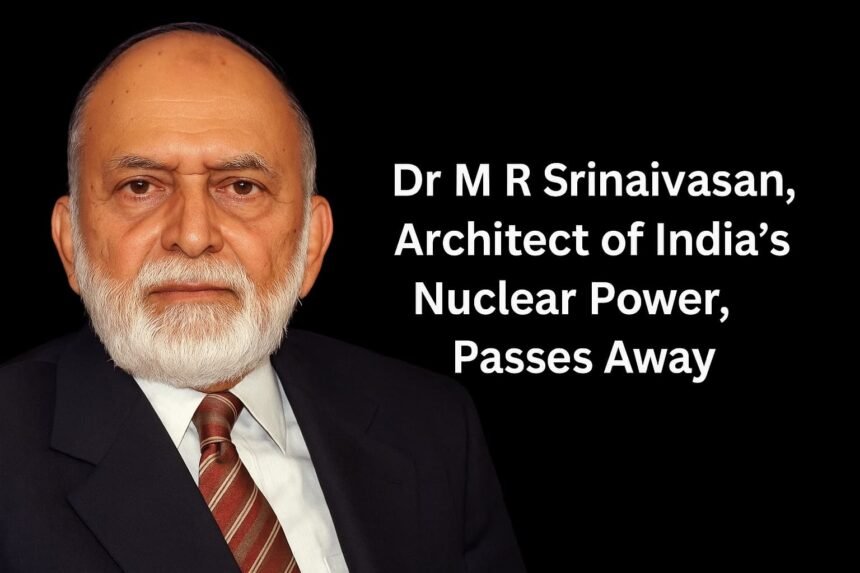M R Srinivasan’s Leadership Journey at the Atomic Energy Commission
India mourns the loss of one of its greatest scientific visionaries. Dr. M R Srinivasan, the architect behind India’s nuclear power programme, passed away on May 20, 2025, at the age of 95 in Ooty, Tamil Nadu. His life wasn’t just about reactors and radiation — it was about resilience, vision, and unwavering patriotism.
This article walks you through seven defining milestones that showcase why M R Srinivasan’s name is etched in India’s atomic history.
1. Humble Beginnings of a Nuclear Giant
To appreciate the roots of Dr. M R Srinivasan’s remarkable journey, here’s a look at his early life and academic milestones:
| Milestone | Details |
|---|---|
| Birth | January 5, 1930, in Bengaluru, Karnataka |
| Early Education | Raised in Mysore; developed a passion for physics |
| Engineering Degree | Mechanical Engineering at UVCE, founded by M Visvesvaraya |
| Higher Studies Abroad | Master’s in Engineering and PhD from McGill University, Canada |
| Specialization | Gas Turbine Technology |
| Age 25 | Ready to revolutionize India’s nuclear future |
2. Handpicked by Bhabha: A Rare Honor
In 1955, he joined India’s Department of Atomic Energy (DAE) — and was personally mentored by Dr. Homi Jehangir Bhabha, the father of India’s nuclear programme. This wasn’t just a job — it was a mission of national importance.
Together, they built Apsara, India’s first nuclear research reactor, which went critical in 1956. It marked the first time India harnessed the atom — not for war, but for peace.
3. From Vision to Reality: Powering India
To better understand Dr. M R Srinivasan’s early leadership in India’s nuclear journey, here’s a quick snapshot of his pivotal roles:
| Year | Key Role/Project |
|---|---|
| 1959 | Appointed Principal Project Engineer for India’s First Atomic Power Station |
| 1967 | Became Chief Project Engineer for Madras Atomic Power Station (MAPS) |
These were not easy times. There was limited international support, frequent sanctions, and intense geopolitical pressure. Yet, Srinivasan’s quiet strength and sharp engineering mind made the impossible, possible.
4. Chairman with a Cause: Transforming the Atomic Energy Commission
In 1987, he reached the pinnacle of his career. He was appointed:
- Chairman of the Atomic Energy Commission
- Secretary of the Department of Atomic Energy (DAE)
- Founding Chairman of the Nuclear Power Corporation of India Limited (NPCIL)
Under his leadership, India witnessed the birth of 18 nuclear power units — a monumental achievement. Of these:
- 7 were operational
- 7 under construction
- 4 in advanced planning stages
His ability to balance science, diplomacy, and national interest kept India’s nuclear ambitions alive, especially when the world tried to shut us out.
5. Global Influence: Taking India’s Expertise Abroad
Srinivasan wasn’t just a national figure — he was a global expert. From 1990 to 1992, he served as Senior Advisor to the International Atomic Energy Agency (IAEA) in Vienna. He brought India’s nuclear philosophy — “atoms for peace” — to the global stage.
Later, he joined India’s Planning Commission (1996–98) and contributed to policies on energy, science, and technology.
6. Beyond the Atom: Shaping Policy and Education
Srinivasan’s brilliance wasn’t confined to labs. He served twice on the National Security Advisory Board (2002–2004 and 2006–2008) — a testament to the trust India placed in his judgment.
From 2002 to 2004, he led Karnataka’s Task Force on Higher Education, striving to improve the future of India’s youth. His love for learning never faded.
7. Honours That Speak Volumes
In recognition of his unmatched contributions to India’s nuclear journey, Dr. M R Srinivasan was honored with some of the highest civilian awards:
| Award | Year |
|---|---|
| Padma Shri | 1984 |
| Padma Bhushan | 1990 |
| Padma Vibhushan | 2015 |
He was also a founding member of the World Association of Nuclear Operators (WANO) and a fellow of the Indian National Academy of Engineering and the Indian Nuclear Society.
He worked alongside Indian science legends — Vikram Sarabhai, Homi Sethna, Raja Ramanna, P K Iyengar, R Chidambaram, and Anil Kakodkar — helping shape the destiny of India’s scientific future.
Legacy: A Nation Forever Grateful
M R Srinivasan’s passing is not just the end of a life — it is the closing of a glorious chapter in India’s scientific journey. Yet, his vision lives on in every nuclear plant, in every lightbulb powered by atomic energy, and in the dreams of every Indian scientist working today.
He once said, “Our aim is not to match the world weapon for weapon, but to bring power to our people, safely and peacefully.”
And he did just that.
Final Thoughts: From Apsara to Atmanirbhar
Dr. Srinivasan showed the world that India could stand tall, innovate independently, and power its people with pride. In a world of superpowers, he made India a supermind.
If you’re inspired by M R Srinivasan’s story, explore how India continues his legacy in science, energy, and innovation.
Most read: https://tnheadlines24.com/isro-mission-failures/
Disclaimer: The information provided in this article is for general informational purposes only. While TN HEADLINES24 strives for accuracy, we do not guarantee the completeness or reliability of any data or statements mentioned. TN HEADLINES24 is not responsible for any actions taken based on the content herein. Views expressed are solely those of the individuals or sources cited and do not represent the official position of TN HEADLINES24.








